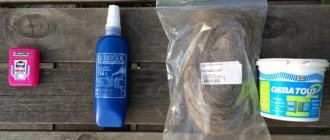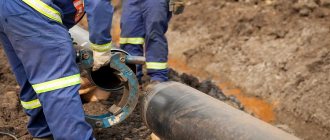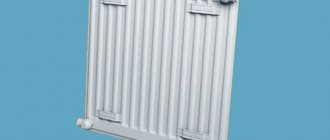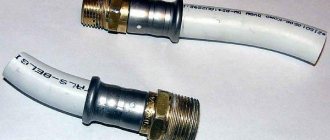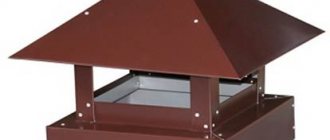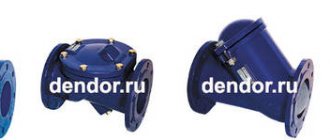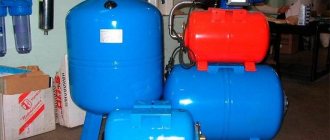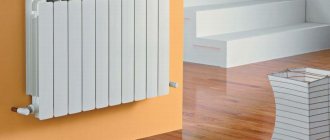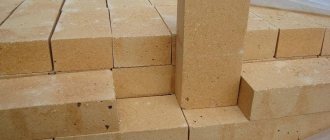Is tightness really necessary?
Brick stoves and fireplaces can crack due to uneven heating of the masonry, including if there is no protection with a layer of plaster or tiles. If through gaps appear in the design of the heating equipment, this entails not very pleasant consequences. Namely:
- Fuel consumption increases as the oxygen supply becomes larger.
- Soot can penetrate into living rooms and settle on the walls and ceiling.
- Combustion products, primarily carbon dioxide, enter the rooms, which can negatively affect human health.
Cracks in brick smoke exhaust ducts and cracks in a metal pipe for removing combustion products make the draft lower, while the heating structure is unable to function normally. This affects the fact that the fuel is burned at lower temperatures and produces a lot of ash, and more soot settles on the inside of the chimney pipe.
A lot of soot and a leaky chimney is a rather dangerous combination. Due to the penetration of air, the soot flares up, and it burns at temperatures above 1500 ° C, and causes the smoke exhaust ducts to heat up. A thin layer of high-temperature sealant does not prevent wood structures from charring, which creates a serious risk of fire.
In the case of gas boilers, cracks in the chimney pipe cause the burner to go out. To avoid regular checks of the boiler's performance, leaks in the chimney are sealed with a special sealant.
Even when installing sandwich-type chimneys, the joints of the sections should be sealed with high-temperature sealant. But the sealing agent must be applied carefully so that in the future it will be possible to separate the sections and carry out dismantling if necessary without consequences.
How to use?
Before using sealant, the work surface must be prepared. The adhesion of most sealants exhibits their properties well on surfaces that are dry and free of dirt, fats and oils. If the material is porous, it must either be scraped or sanded to a hard state, or primed well. It is recommended to first coat the wood surface with varnish or paint, and after it has dried, use a sealant. Metal, glass, and ceramics are first degreased with alcohol-containing liquids or acetone. It is best to treat polymers only with alcohol.
A sealing material is applied to the prepared surface. To do this, use a cartridge with a special nozzle or a special device in the form of a mounting gun. The sealant is applied to the joint so that the joint is completely covered with the sealing compound. There are special devices that help level the seam, making it uniform and aesthetically pleasing. Sometimes the sealing compound is applied with a rubber spatula, the width of which is selected depending on the object being processed.
Fireproof adhesive for fireplace cladding
7 best bathroom sealants
Heat-resistant tile adhesive for finishing stoves and fireplaces
If it is necessary to line the fireplace with decorative tiles or stone, then it is necessary to use glue specially designed for this. The composition is dominated by mineral components, which provide high plasticity and adhesion - adhesion of surfaces. As a result, the likelihood of tiles falling off during the operation of the fireplace is reduced.
For cladding, in addition to clay-based glue, a heat-resistant solution of soapstone powder with liquid glass is often used. Soapstone is a natural stone, also called soapstone, and contains talc, magnesite and chlorite. Crushed stone is used for glue; the fractions must be very small so that the connection with liquid glass is uniform.
This glue is also called Finnish, it is distinguished by high heat transfer, thanks to which the fireplace will heat the room faster, as well as by its plasticity and elasticity under the influence of high temperature.
Advantages and disadvantages
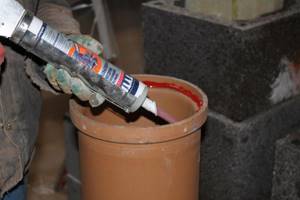
The advantages and disadvantages of the material depend on its base. The advantages of high-temperature silicone include:
- good adhesiveness;
- resistance to wet environments;
- resistance to UV radiation;
- maintaining the integrity of the structure under abrasive influences;
- immunity to temperature fluctuations;
- ease of application.
Among the disadvantages is the impossibility of painting the surface and processing a wet base. Acidic modifications are not compatible with all types of materials.
The silicate heat-resistant composition has the following advantages:
- maintaining integrity when exposed to high temperatures;
- good strength indicator;
- no shrinkage;
- possibility of subsequent surface painting;
- long service life.
The disadvantages of the paste include lack of elasticity and minimal adhesion to a smooth surface.
Types of sealants and materials
Types, properties and application of heat-resistant sealants for stoves and chimneys
The main component of sealants is polymers. In this case, different polymers are used and impart different characteristics to the main composition. They are packaged in tubes of different sizes and configurations. Some resemble tubes of toothpaste and are squeezed out the same way. There are tubes for a mounting gun. In this case, the spout on the cap cone is cut off, the tube is installed in the device, squeezing out the required amount using a trigger lever.
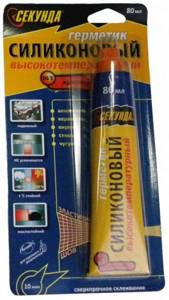
Heat-resistant sealant in a tube
There are two-component formulations that need to be mixed before use. They are more often used by professionals due to strict requirements: when mixing, parts must be measured with high precision (the permissible error is only 0.5-1 grams). In addition, if even a small part of one component accidentally gets into another, a reaction occurs, and the shelf life of the mixture is only a few hours. In general, ready-made paste sealants are easier to use.
Special high-temperature compounds are used for chimneys and stoves. Sealants that can withstand high temperatures come in two categories:
- Heat resistant. Used for places that heat up to 350°C. The area of their use is the external surfaces of stoves and fireplaces - gaps between masonry bricks (but not between stove casting and masonry), sealing joints of brick chimneys, sandwiches and roofs (but not simple metal chimneys), parts of the heating and hot water system, etc. d.
- Heat-resistant or heat-resistant. Withstands very high temperatures - up to 1500oC. Scope of application: if we talk about stoves and fireplaces - joints between casting and masonry, in boilers - in combustion chambers or fireboxes, in chimneys - joints and seams, including immediately after the chimney outlet. These compounds can be used in areas of direct contact with flames, but then there must be another characteristic: fire-resistant or fire-resistant.
Depending on the temperature and required characteristics, use one of these sealants. So, depending on the area of application, the oven sealant can be either heat-resistant silicone or heat-resistant silicate. To understand the difference between them, what they are, and how to use them, let’s look at the properties and characteristics.
Heat-resistant (silicate) pastes
This type of sealant is used in the hottest areas of fireplaces and stoves, where temperatures can exceed 1000°C degrees. Some pastes can withstand short-term exposure to 1500°C heat. A silicate sealant is used inside the firebox, where direct contact with fire is possible. Its purpose is quite standard - a connecting link when joining elements and a filler in cracks. But the choice falls on heat-resistant paste not only because of high temperatures.
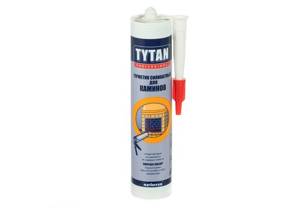
These materials are endowed with many distinctive qualities. Among them, instability to vibrations occupies an important place. The hardened silicate sealant crumbles and collapses when deformed. They should process those elements that remain static when the fireplace is operating. These are the places where cast iron parts and brickwork meet.
Typically, heat-resistant pastes are black in color, which indicates the presence of sodium silicate in them.
Their disadvantage is that they are poorly bonded to parts that have a smooth surface. Therefore, before applying the sealant, you will have to carry out preparatory work. They have a strictly defined algorithm:
- The surface is cleaned of dust and unstable particles.
- It is treated with a solvent for the purpose of degreasing.
- A smooth surface will have to be rubbed with coarse sandpaper or a metal brush (brush) to increase the area of contact of the paste with the element.
- Before applying the sealant, it is recommended to moisten the area with water.
If the main task of the repair is to seal the seams, then the surfaces located in the immediate vicinity must be protected from accidental contact with sealant. To do this, masking tape is glued along the entire length on both sides of the seam. After the first signs of hardening of the paste, this tape can be removed. But the sealant will completely harden only after a day.
Before starting the fireplace, check the tightness of the seams. Close the chimney and light a small piece of newspaper in the firebox. If smoke enters the room through a problem area, this indicates low quality of the work performed. The fireplace should be put into operation in stages, gradually increasing the operating temperature. Abruptly reaching the maximum value during the first run is not recommended.
Only the manufacturer can indicate the main characteristics in a more precise range. Among the popular brands of all types of sealants, the following stand out: Penosil, Soudal, Tytan and Mastertex F. This is not a complete list of brands and you should not limit yourself to their use.
Main types of high temperature sealants
Types of roofing sealants and rules for their use on different roofs
There are different types of sealants on the market that have the ability to withstand high temperatures. To seal defects in stove masonry, it is better to buy those that contain silicates and silicone. The products are packaged in small cylindrical cartridges, which are convenient to insert into a mounting (glue) gun.
You can also find small packages on sale in tubes resembling a paste, which are used like any regular glue. A variety of colors allow you to choose the composition to match the color of the base material in order to make the “patch” aesthetic or completely visually invisible. All sealants are divided into heat-resistant, heat-resistant, sealing and cladding properties.
Heat-resistant sealants
The basis of such products is silicone, they can withstand up to +350 degrees. To achieve such heat resistance, iron oxide is also introduced into the composition, so the main color of the mass becomes orange. Some products contain acetic acid; they are absolutely not suitable for iron - by creating an oxide film, sealants will not provide sufficient adhesion. But they can be used for aluminum, other non-ferrous metals and stainless steel, although for any metal it is better to purchase an acid-free composition.
Typically, heat-resistant sealants are used for application to the outer walls of fireplaces and stoves. They are also suitable for open areas where the seam will be affected by atmospheric factors and ultraviolet radiation - for example, for roofing made of corrugated sheets or tiles. You can use compounds to eliminate cracks in chimneys or car parts. The thermal resistance limit is always indicated on the packaging. We must remember that +350 degrees is the upper limit of a short-term increase in temperature. Constant heating should not exceed +250...+270 degrees.
Polymerization of the sealant occurs in a few hours; some heat-resistant products harden only after 1-2 days. The closer the expiration date is, the faster this process occurs. The ideal conditions for polymerization of the sealant are considered to be a temperature of +23...+25 degrees, humidity 50%. Other conditions will slow down or speed up the complete cure of the material.
Heat-resistant sealants
Such products contain silicates, therefore they are designed for more severe heating - up to +1500 degrees, and even direct exposure to flame is possible. The spacer layer between bricks, cast iron elements of the stove masonry, the seams of the combustion chamber, and defects in heating boilers should be repaired with heat-resistant sealants. Sealants do not lose their properties even under extreme heat, but when exposed to open flame, you need to find in the instructions the manufacturer’s direct indication of this possibility.
The color of heat-resistant sealants is usually black or gray due to the presence of silicates. They adhere perfectly to any materials, but it is still recommended to sand the surface before application. Work should be carried out at a temperature close to +20 degrees. After drying, the seam will be stiff, since such sealants are not very elastic. It is better not to use them on products subject to vibration, but they are perfect for structures that have already undergone shrinkage.
Silicone seals
You can also find semi-liquid silicone paste in red or blue shades on sale. As it hardens, it forms an elastic seam that can stretch 2 times. Such sealants are used for new masonry that is subject to severe shrinkage. You can also use seals to cover the outside of sandwich chimneys. The products cannot withstand high heat - they only work within the range of -40...+250 degrees. The maximum depth of the seam should not be more than 6 mm, application is carried out at +5…+30 degrees. The most popular brands of silicone seals are Titan, Moment-Germent, Penosil.
Adhesive facing compositions
Materials with adhesive properties are used if the stove masonry is covered with a network of cracks, because it is unrealistic to treat the entire area with a conventional sealant. Facing compounds penetrate perfectly into the narrowest and deepest cracks, reliably hiding them. After repair, the fireplace and stove will acquire a more aesthetic appearance. Typically, such mixtures are sold in buckets in finished form or in bags in the form of a dry powder. The heat resistance of facing compositions may vary:
- mixtures based on kaolin dust, chamotte - up to +400 degrees;
- one-component adhesives with mineral additives – up to +800 degrees;
- mastics for gluing tiles and stones - up to +1000 degrees.
Rules and principles for sealing chimneys
When working with two types of polymers, it is necessary to prepare the surface of the flue: clean, remove dust and dirt, and degrease. Metal areas must be sanded with fine sandpaper for effective adhesion of the polymer material. The surface under the heat-resistant seal must be absolutely dry. The tube is inserted into the gun and a small amount of material is squeezed onto the edge to be sealed. They provide the opportunity to harden; the polymerization time is usually indicated on the packaging.
The base for the heat-resistant silicate polymer is prepared and slightly moistened. Carefully apply the sealant to seal the gap tightly and allow time to harden. Excess heat-resistant mass is removed before it petrifies. It is possible to pre-glue the length of the seam with masking tape, and then remove it after completion. Activities are recommended to be carried out during the warm period of the year.
Some important rules when using heat-resistant sealants:
- Work with silicate sealing components is carried out in a temperature range from +6 to +41 C.
- The desired connection result is achieved only in the case of rough and uneven surfaces. For this purpose, when used, the areas are pre-treated with grinding materials.
- The surfaces must be degreased with a solvent, after completing the stage, allow them to dry for 20-25 minutes.
- When the mass hardens in the areas where the sealant is applied, very strong and hard seams are obtained; for this reason, it is not recommended to use these heat-resistant kits for systems operating in conditions of high vibration.
- The remaining sealing material is removed with a damp rag, but only until the paste hardens. After polymerization, this will require the use of force and tools.
Rules for using thermosealants
The tactics for using silicone and silicate mixtures are similar. However, there are also features that should be kept in mind when sealing furnace equipment.
Working with silicone compound
In addition to the construction tools for work, you need to prepare: a rubber spatula, latex gloves, and a brush.
The surface to be treated needs preparation:
- clean and degrease the base;
- It is advisable to treat metal elements with sandpaper to improve adhesion;
- wait for the surface to dry completely if water was used during cleaning.
The next stage is filling the cylinder into the construction gun. Cut off the sealed cap at an angle.
It is desirable that the thickness of the extruded sealant be slightly less than the width of the seam or crack being processed
For uniform hardening, the silicone composition must be provided with air access. Therefore, the thickness of the sealant recommended by the manufacturer cannot be exceeded.
The time for complete polymerization depends on the conditions. The packaging indicates the rate of hardening at optimal parameters: humidity - 50%, temperature - 23°C. In practice, the values vary significantly. The lower the room temperature, the longer it will take for the sealant to “set.”
Technology for applying heat-resistant sealant
To process with a refractory compound, in addition to the tools and materials described above, you will need masking tape and a construction knife.
Adhesive tape is necessary to protect the outer coating - the sealant dries quickly, and then removing it from the base will be problematic
The surfaces are prepared in the same way as before applying the silicone composition: cleaned, degreased, and the metal is “sanded” with an abrasive.
Technological nuances of using silicate sealant:
- the porous base must be dusted and slightly moistened;
- work is carried out only at above-zero temperatures, optimally above +20°C;
- when applying the mixture, adhere to the insulation thickness recommended by the manufacturer;
- excess sealant must be removed immediately, without waiting for the mixture to dry;
- The masking tape is removed after applying the composition.
Some oven sealants require many hours of drying at different temperatures. This information must be clarified in the product instructions.
Working with thermosealant for stoves and fireplaces
You can use different sealants for fireplaces and other heating structures made of brick, but in any case you will need the following tools and materials:
- rubber spatula;
- knife;
- masking tape;
- rubber gloves.
First, we “load” the gun. Cut off the tip of the tube and put a cap on it. We insert the cylinder into the gun. Before applying silicone sealant, the surface must be prepared: cleaned of dirt, dust, and polyurethane foam residues. The surface is cleaned if it is very smooth. This is necessary for better adhesion. It is better to carry out all work at above-zero air temperatures.
The sealant should not be used on a damp surface. After cleaning with water, you need to dry everything well.
To apply heat-resistant sealant for boilers, similar preparation procedures are carried out. Then masking tape is glued along the crack on both sides and filled with paste. Excess that gets into the tape is removed with a rubber spatula. At the initial stage of compaction (after a few minutes), the masking tape is removed and the time specified in the instructions is waited.
Well-known sealant manufacturers
The following manufacturers have proven themselves well in the group of fireplace and stove sealants:
The company that produces one of the most famous models of heat-resistant sealant is Penosil +1500.
Sealant for fireplaces and stoves from the famous manufacturer Penosil. Pistol release form
It is able to withstand temperatures up to 1500 degrees Celsius. The range also includes a heat-resistant sealing compound. It is a red silicone acid paste that can withstand temperatures up to 300 degrees Celsius.
https://youtube.com/watch?v=AyKcbgsGbxw
Video: review of sealant for PENOSIL ovens
Soudal C. A company from Belgium that produces a wide range of sealing compounds. The heat-resistant versions of the Soudal Calofer series are most often used for repairing stoves or fireplaces. You can also choose mixtures called Fix All.
On the right side there is a sealant for furnaces from the manufacturer Soudal C, which is successfully used for repair work
Tytan. This brand produces products from a Polish company called Selena Group. Most often, professionals choose these products. The high-temperature sealant of this brand contains a mixture of glass fibers, which ensures excellent gas and smoke resistance. Temperature withstands up to 1250 degrees Celsius. It is intended for chimney pipes, as well as fireplaces or stoves.
Neutral silicone sealant Tytan from the famous manufacturer Selena Group, which many fireplace owners use to repair them
Sealant for repairing fireplaces and stoves is an indispensable item. As when purchasing other materials for construction, before making a choice, you should familiarize yourself with the tips and characteristics. High-temperature sealants have a lot of advantages and distinctive properties, which depend on the composition, so the wrong choice can lead to errors and insufficient tightness.
MAKROFLEX
MAKROFLEX is an Estonian company that produces various sealing compounds and insulating materials. Its product range includes fireproof and heat-resistant sealants, which have long been used in construction and renovation and have earned many positive reviews.
"MAKROFLEX HA147" is a fire-resistant sealant based on inorganic compounds. Hardening of this composition occurs as a result of the evaporation of water from it, after which a rigid compound is formed that is resistant to cracking and high temperatures. It is used for repairing connections with low mobility, which are exposed to high temperatures, reaching up to 1200 permanently and up to 1500 degrees for a short time.
This sealant is used for various materials - brick and concrete, glass and steel, cast iron and anodized aluminum.
Cartridge with sealant "MAKROFLEX HA147"
This sealing material has the following advantages:
- excellent resistance to open flame;
- high adhesion with most modern building materials;
- this sealant is not subject to shrinkage;
- it does not emit smoke or other harmful fumes;
- when frozen, it is susceptible to staining.
Areas of application for MAKROFLEX HA147:
- sealing various gaps in furnaces, both in brick and metal;
- sealing connections in contact with open fire;
- installation of combustion chamber lining;
- fixation of fire-resistant slabs and panels;
- sealing connections in electric furnaces, ovens, chimneys, as well as in car exhaust pipes.
Krass
“Krass fireplaces and stoves” is a Russian-made sealing compound that is highly fire resistant. This sealant is intended for the construction or repair of brick stoves, heating devices and units in areas exposed to open fire. The composition can withstand temperatures reaching up to 1250 degrees.
Tube of heat-resistant sealant “Krass fireplaces and stoves”
The sealant is made on the basis of liquid glass and has a black color. It is wear-resistant, gas-tight, and forms a non-shrinking rigid seam. The paste has high adhesion to stone, brick, metal and ceramics. The composition does not spread when applied, and when hardened it does not crack. It can be used to seal surfaces or chimney joints outdoors as it is weather resistant.
This composition is characterized as follows:
Properties and nuances of choosing sealing pastes

Heat-resistant sealant for furnaces has several properties:
- Ability to withstand temperature exposure. Heat-resistant ones heat up to 1500 degrees, heat-resistant ones - up to 300 degrees.
- Good connectivity. Rubber-based silicone materials are used as an adhesive for ceramics, wood, and glass.
- Hardening speed. Depends on the number of components. The one-component sealant hardens in 1 minute and is applied in a layer of 2-12 mm. Two-component (polymer + catalyst) harden in a few hours.
- Color. Determined by additives in the composition. Red ones are suitable for overlay with a layer of 6 mm and have good adhesion. Black heat-resistant pastes are used to process the front part of the oven. Colorless - characterized by vulcanizing ability and strength.
Sealants of any color will fully cure after 24 hours.
When purchasing materials, you should check the composition. Silicone pastes do not ignite well, but polymer pastes (acrylic, polyvinir) easily ignite and leave black soot.
The compositions in tubes for the gun are economical in consumption. Silicone can be used for outdoor work, silicate - for heated areas, tapes - for stainless steel chimneys, glue - for lining stoves and brick chimneys.
Acid-based sealants are not applied to concrete or metal. After hardening, they will begin to corrode the surface. Alcohols from neutral pastes evaporate after application, and the seam remains strong and elastic.
Manufacturers put markers on the packaging that can be used to judge the degree of fire resistance (El and numbers), time of loss of integrity (E), and period of thermal insulation (l).
To seal a seam or surface with high-temperature paste, you will need a putty knife, a gun and masking tape. The tube with sealant is installed in the gun, a piece is cut off from the top. A cap is placed over the gap. It is better to protect your hands from sticking of the mixture with gloves.
How to choose a sealant for a car?
First of all, let's focus on applicability. If we need to fit a pan, valve cover, and so on, we just need to choose from among the universal silicone sealants. The main thing is not to even look in the direction of acetate (“vinegar”) compositions; they are not applicable for cars, especially in cases where the evaporation of the polymerizing sealant gets to the catalyst and lambda probe. If we are talking about “hotter” places, like the exhaust manifold flange at the point where it adjoins the cylinder head, then it’s worth looking towards high-temperature sealants. The main thing is not to make the mistake of choosing repair paste-sealant for exhaust systems for this place: they are designed for sealing non-separable connections!
If we are talking about a tight junction of two metal parts, make sure in the repair instructions (they, of course, are intended for authorized technical centers, but they leak so quickly onto the Internet...) that the use of a gasket-forming sealant is allowed in this assembly. If the manufacturer requires the use of only anaerobic sealant, it cannot be replaced with any other compounds.
Next, we check compatibility with operating fluids. Moreover, ideally, it should not just be described in general terms on the packaging, but also described in detail in the technical specifications sheet. And, by the way, if the manufacturer does not publish anything like this (yes, Done Deal, this is addressed to you), then it is better to turn to someone else. If, for example, we are working with a valve cover, then first of all, compatibility with engine oil is important to us; for a gearbox cover, resistance to transmission oils is required (their chemical composition is significantly different). But when installing a pump, the most important thing for us is compatibility with ethylene glycol.
How to use?
Before using sealant, the work surface must be prepared. The adhesion of most sealants exhibits their properties well on surfaces that are dry and free of dirt, fats and oils. If the material is porous, it must either be scraped or sanded to a hard state, or primed well. It is recommended to first coat the wood surface with varnish or paint, and after it has dried, use a sealant. Metal, glass, and ceramics are first degreased with alcohol-containing liquids or acetone. It is best to treat polymers only with alcohol.
A sealing material is applied to the prepared surface. To do this, use a cartridge with a special nozzle or a special device in the form of a mounting gun. The sealant is applied to the joint so that the joint is completely covered with the sealing compound. There are special devices that help level the seam, making it uniform and aesthetically pleasing. Sometimes the sealing compound is applied with a rubber spatula, the width of which is selected depending on the object being processed.
Peculiarities
The main active component in the sealant is a polymer material. Depending on the purpose of use, it can be silicone, silicate, rubber, bitumen. The sealant is produced in tubes intended for manual use or using a special feeding device - a mounting gun.
Depending on its composition, heat-resistant sealant is produced in three types - one-, two- or three-component.
A one-component sealant is a product that can be used in finished form, and the polymerization process of the composition occurs at room temperature for several hours. In this case, it is not necessary to apply a thick layer of sealant - a layer with a thickness of 2 to 10 millimeters will completely cope with the task assigned to it. Each manufacturer indicates more specific parameters on the packaging of their products and they may differ between different brands.
- A two-component sealant consists of a base and a catalyst. The polymerization process occurs through the interaction of these two components. The resulting mixture must be used immediately, as it cannot be stored.
- A three-component sealant consists of a main component, a curing composition and a catalyst that accelerates the vulcanization process.
Sealants used in high temperature conditions are divided into two categories.
- Heat-resistant sealants can withstand temperature loads within 1300 degrees. The components of such a sealant are capable of contact with an open flame. The product contains sodium silicate. In turn, heat-resistant sealants are fire-resistant or fire-resistant. The difference between them lies in temperature conditions and a number of characteristics.
- Heat-resistant sealants can be used in those areas of the structure that do not exceed a heating temperature of more than 350 degrees. As a rule, these are elements of joints, connections and cracks on the outer surfaces of the structure.
Depending on the composition of the polymer substance, sealing products come in several types.
- Acidic sealants that form acetaldehyde during polymerization. This substance can destroy or deform the surface that reacts with it. Therefore, acid sealants can only be used to a limited extent. For example, metal surfaces will quickly corrode, and concrete or cement will produce powdery oxidation.
- Neutral - a type of sealants that consist of heat-resistant silicone and release water and ethanol during the polymerization process. Their use is safe for all types of surfaces, and therefore these sealants have a fairly wide range of uses. The silicone seam is perfectly restored after any deforming influences, and its service life is at least 15 years.
In addition to their distinctive features, all types of heat-resistant sealants share common properties.
- Adhesiveness – polymer components included in all sealing heat-resistant products have good adhesion to working surfaces. They can be used on brick, concrete, metal, glass, ceramic, wood or plastic structures.
- Plasticity – sealing seams have a certain plasticity after the polymerization time has ended. They do not crack and are resistant to vibration and temperature changes.
- Water resistance – polymer materials have increased resistance when interacting with water and steam.
- UV resistance – polymer sealants are not susceptible to the destructive properties of ultraviolet rays.
According to the scope of application, heat-resistant sealants can be divided into three types.
- for use in construction and installation work;
- used for repairing motor vehicles;
- sealants for narrow-profile special purposes.
Types of sealing compounds
The main component of all sealants are polymers.
If SMX hybrid polymers are used as a base, such adhesive and sealant can withstand temperature loads of up to + 200 ℃ for a long time. These are moisture-resistant and chemically neutral compositions, the rate of hardening of which does not depend on humidity and temperature. They are ideal for reliable connection and fixation of plumbing products, suitable for external and internal use, resistant to water and ultraviolet radiation. The only drawback of such sealants is their limited temperature range.
Sealants that can withstand high temperatures can be:
The use of heat-resistant sealants is limited to an upper temperature limit of +350 ℃. Heat-resistant materials can withstand heating up to a thousand degrees or more. Even when destroyed, they do not support combustion and can come into direct contact with fire or a hot surface.
Let's outline the scope of application
Construction supermarkets sell many sealing pastes used in heating, plumbing and sewerage systems. You must understand that ordinary food and plumbing sealants are not high-temperature, although they are used for installing some elements of chimney pipes.
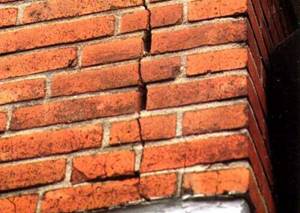
Water- and heat-resistant sealants are used for steel stoves, masonry, and fireplace repairs. Application options:
- Sealing cracks and holes in the walls of a combustion chamber built of brick or welded metal.
- Sealing chimney pipes during repair or installation.
- Exterior finishing of brick fireplaces and stoves.
- Bonding heat-resistant gaskets (asbestos and graphite-asbestos cords) to metal fittings - doors, valves, iron ovens and cast iron stoves.
- Waterproofing of roof junctions with chimneys made of metal and brick.
A crack in the stove masonry or welded joint of a steel firebox leads to smoke in the heated room and the formation of soot in the defect area. The traditional way to eliminate it is to move the stove or cover the through gap with clay. Modern high-temperature sealant allows you to solve the problem much faster and more efficiently.
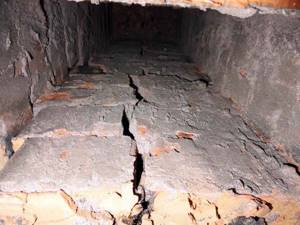
The suction of street air into the chimney pipe is a very unpleasant phenomenon. More condensation and soot fall on the walls, which can ignite at any time due to the high temperature of the flue gases. Hence the need arises to seal the connections between the chimney elements. We will discuss other methods of application in detail during the review of repair compositions.
Advantages and applications of thermogemetic agents
Heat-resistant sealants can be useful in a variety of situations. They can be useful when installing heated floors and for arranging ventilation ducts.
Sealing compounds are indispensable when repairing built-in equipment, as they can protect equipment and devices from moisture, but most often heat-resistant sealants are used for heating structures. When operating this equipment, emergency situations are inevitable, especially for stoves, fireplaces and chimneys.
In any brickwork, cracks and through gaps appear over time. Such damage reduces the efficiency of the stove itself and impairs draft, which contributes to smoke and can be dangerous to humans.
Big problems also arise when the seals of chimneys are broken. If the soot accumulated on the chimney is not removed promptly, it may ignite when exposed to air.
Non-flammable sealants with fire-resistant properties allow you to prevent serious consequences and quickly eliminate problems. They perfectly fill any gaps, seams and cracks. There are often cases when it is simply impossible to do without the use of thermosealants.
In some areas of heating systems, temperatures can reach over 1300 ℃. Thermal changes break the seal, which can lead to a fire hazard. Not every known building composition is able to withstand the test of open fire.
Heat-resistant sealants are prepared for such extreme loads and effectively provide connections with a reliable seal. By protecting against fire, fire-fighting compounds guarantee the safe and efficient operation of heating equipment.
Manufacturers of high temperature sealants
Heat-resistant sealants are available in the range of most major brands:
- Soudal Gasket Seal is a high temperature silicone sealant that remains flexible after curing. Properties are maintained up to +285 degrees. It is oil and petrol resistant, not afraid of water and antifreeze. Used in industry and construction, for boilers and kitchen equipment, as an automotive gasket, to form O-rings in engines and pumps.
- Penosil 1500 is a heat-resistant high-temperature sealant that can withstand up to +1500 degrees. The base is sodium silicate. It is suitable for stoves, fireplaces, chimneys, central heating boilers, installation and repair of other stove equipment. Soudal also has similar material.
- Red heat-resistant sealant Tytan is an acidic high-temperature sealant for arranging joints. The operating range is from -65 to +260 degrees. Temporarily the mass can withstand up to +315 degrees. The first film sets on the surface within 15 minutes.
- Abro Red is a red high temperature gasket sealant for cars. It comes in small, convenient 85 g tubes with a removable nozzle. Operating mode: up to +343 degrees. The thin nozzle allows you to form a gasket up to 6 mm. Oil-resistant material withstands compression, shear and tension.
- “Moment Germent” is a silicone heat-resistant adhesive-sealant for high temperatures, up to +315 degrees. It is UV and ozone resistant. Adheses well even to weak and porous substrates. Used in pumps, motors, furnaces, chimneys. Suitable for connecting heating elements made of metal. The color is red-brown.
- Permatex high-temperature anaerobic flange sealant is needed for rigid connections at temperatures up to +204 degrees. It is suitable for tight-fitting seams up to 0.5 mm. When applied, it does not cause corrosion and does not require tightening of fasteners.
- Loctite 5972 is a one-component, high temperature thread sealant available in dark gray or black. The viscous paste does not harden completely and is therefore suitable for compaction. Among the advantages is high adhesion to paper, metal, plastic, and cork. It is used for gearboxes, pipelines, manifolds, heating systems.
- DoneDeal DD6785 is a heat resistant compound for exhaust systems, muffler and exhaust manifold. Contains sodium silicate, clay, synthetic fibers and steel powder. It can withstand up to +1400 degrees and hardens within 3 hours. In particular, it eliminates the emission of combustion products and exhaust gases from cracks and damage to mufflers.
- Victor Reinz is an automotive high-temperature sealant without solvents. It is available in two variations: transparent for the range from -50 to +200 degrees and gray for +300. There are no acids in the composition, so it can be used with plastic, plastic, aluminum, electrical components.
- High-temperature acrylic sealant "Ogneza" is used in the construction of fire safety systems. It is classified as fire retardant. Maximum temperature - up to +1300 degrees. Fire resistance - 2 hours. Such heat-resistant sealants are used for installing cable penetrations.
- Dow Corning Q3-1566 is a sealing adhesive for oven, range and other heating equipment. Suitable for home and industrial furnaces, boilers, heaters, ceramic punches, oil pans, chemical plants.
There are also solutions for the reverse problem. These are frost-resistant sealants that allow you to work at -30 degrees and even lower. Basically, they are needed for outdoor work in harsh climatic regions.
Application in heating systems of sandwich chimneys
Due to their design features, sandwich pipes are gaining increasing popularity due to their high efficiency and durability. The chimney sandwich is based on a large diameter pipe with a smaller diameter pipe placed in it. The gaps between these elements are filled with thermal insulating material, most often mineral wool. Despite the relatively affordable cost of such structures, efficiency and ease of installation always guarantee excellent results.
The sandwich pipe is discharged into a specially made pipe on the roof. The installation of the components of the entire chimney begins with the lower elements, starting with the entry into the heating equipment. At each section of its conduction from the heating equipment to the roof, insulation is performed with heat-resistant material.
The safety and efficiency of such a chimney will depend on the quality of waterproofing of the entire structure. Therefore, at the time of installation of each element inside the building and on the roof, it is necessary to treat all connections with a special heat-resistant sealant.
Installation of a sandwich pipe must be carried out in accordance with technology, which will be quite complex for a novice master. Therefore, it is better to trust the installation of such structures to professionals.
The process of waterproofing a chimney requires special care, since not only the durability of the roof, but also the safety of those who use this heating system depends on the correct implementation of the intermediate steps.
Errors when sealing a bath
Typical mistakes that inexperienced craftsmen make when sealing a steam room:
- Wrong choice of composition. When selecting a sealant for a steam room, you need to pay attention to its characteristics, composition, as well as compliance with the requirements for bath products.
- Violation of the rules for transportation and storage of the product. In this matter, you must follow the manufacturer's recommendations given in the instructions.
- Insufficient preparation of the crown joints of a log or timber bathhouse and adjacent surfaces. Dirt and stains left on the surface will prevent the sealant from adhering well to the wood.
- Application of an insufficient amount of sealant or, conversely, its excess. To work, you need to use a special gun, which can be used to regulate the level of material supply.
- Treating raw wood with sealant or applying the product in unsuitable weather conditions (rain, heat or sub-zero temperatures).
All these and similar errors lead to unreliable and short-lived sealing. To avoid mistakes and get excellent results, contact professionals.

